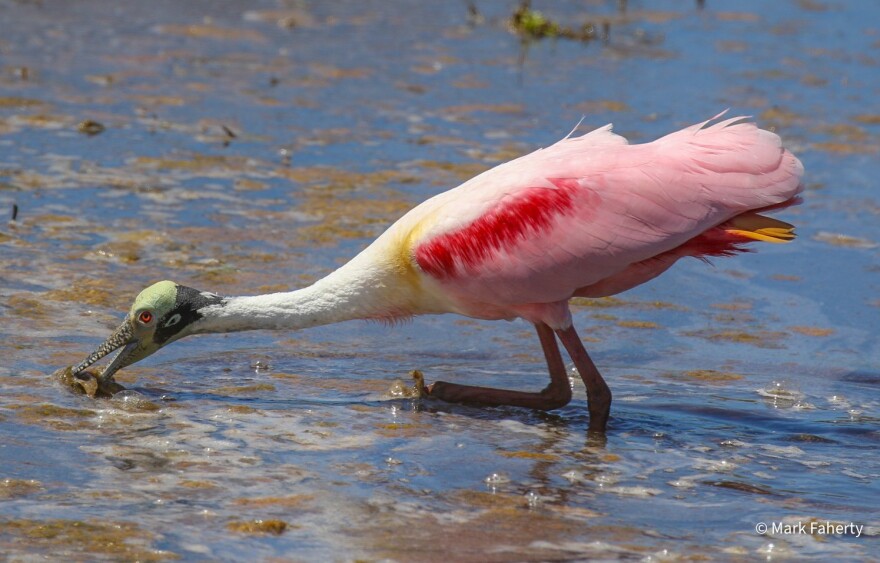While it was an eventful week for birds here on the Cape and Islands, including an epic flight of Northern Gannets after the nor’easter, a rare Townsend’s Warbler banded at Wellfleet Bay sanctuary, and migrating Sandhill Cranes seen two places, this week’s marquee bird has us once again creeping to the edges of the listening area up in Plymouth County. The bird was a Roseate Spoonbill and it was in Marshfield, which is not in the listening area at all - but come on, it was a Roseate Spoonbill!
No one knows who found the bird as it was apparently an anonymous report to Mass Audubon passed along to birders back on the 15th. Word spread and many birders rushed over to the marshes between Green Harbor and Brant Rock, including some of the regular Cape Cod bird chasing crew, and some were rewarded with excellent looks. Some saw the odd, side to side bill swishing they do to feed – when they feel a fish or crunchy invertebrate, they snap the bill shut.
Six species of spoonbills range across every continent except Antarctica, but most of them, other than the spectacular weird beak, are vanilla in that they are all white. Our flamingo-esque Roseate Spoonbill is the only truly flamboyant one, though the Royal Spoonbill of Australia at least flirts with flamboyance, sporting a big, shaggy crown of white feathers and a jaunty yellow eyebrow. But it’s hard to compete with the Roseate – they are a pale but assertive pink across the wings and underparts, with a gash of much deeper reddish pink along the leading edge, plus a little mustard yellow on the shoulder for contrast.
And then there’s that bill of course – it looks like a duck upgraded its bill with a footlong aftermarket extension. As is true in the most virile and handsome of human men, Roseate Spoonbills go bald as they age – juveniles like the bird in Marshfield have heads covered in white feathers, but adults have bald but colorful heads showing a mix of key lime green, orange, black, and sometimes sky blue. The eye turns deep red as they age, and that long spatulate bill goes from pinkish to mottled black and white, like the pattern of a baby alligator – I wonder if this helps keep the big alligators from chomping them as they swish that bill around in the murky water.
Roseate Spoonbills are a Florida bird to us easterners, but most of their range is in South America. You can see them on your winter vacation to Broward County or wherever, but you kind of have to go looking for them – they’ve got a bit more pride than some of the other wading birds, so they’re not hanging around the beaches, parks, canals, and roadside ditches like White Ibises and Wood Storks.
Everyone likes to speculate about how these vagrants get here. Most have posited that this bird was brought north during the storm, which is possible, but I think it may have come from north of us, odd though that may sound. A juvenile spoonbill was found way up in downeast Maine in late July, another in Quebec, and one or two others in way upstate New York as recently as last month. You might remember that flamingo that bounced back and forth between Long Island and Cape Cod a couple of times last summer – these big pink birds can wander around over large areas before they finally disappear for good.
This spoonbill hasn’t been seen in a few days, but as always, there’s a chance this bird could turn up again, maybe somewhere else, maybe even a marsh near you. One of those three uber rare Bar-tailed Godwits I talked about last week was re-found yesterday at Plymouth Beach after a two-week absence. So we should all still be out looking for this spoonbill. I feel like chasing this spoonbill needs it’s own term – birding doesn’t quite cover it. I think I’ll call it….spooning. So let’s all get out there and do some spooning this week!








